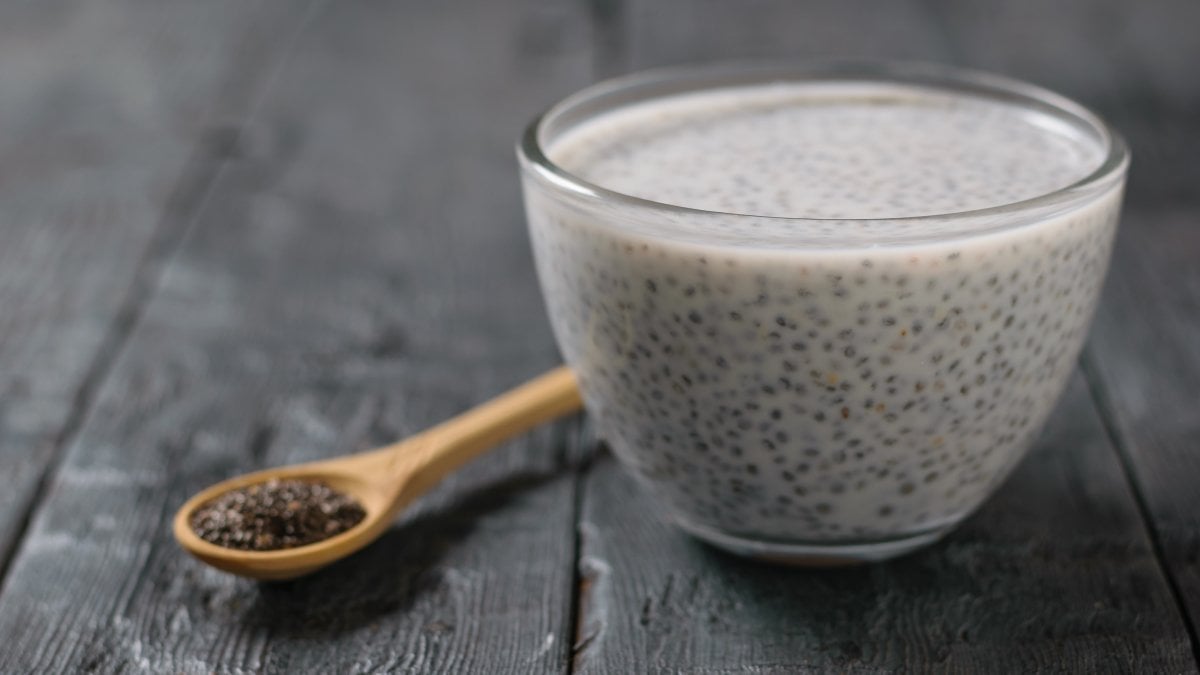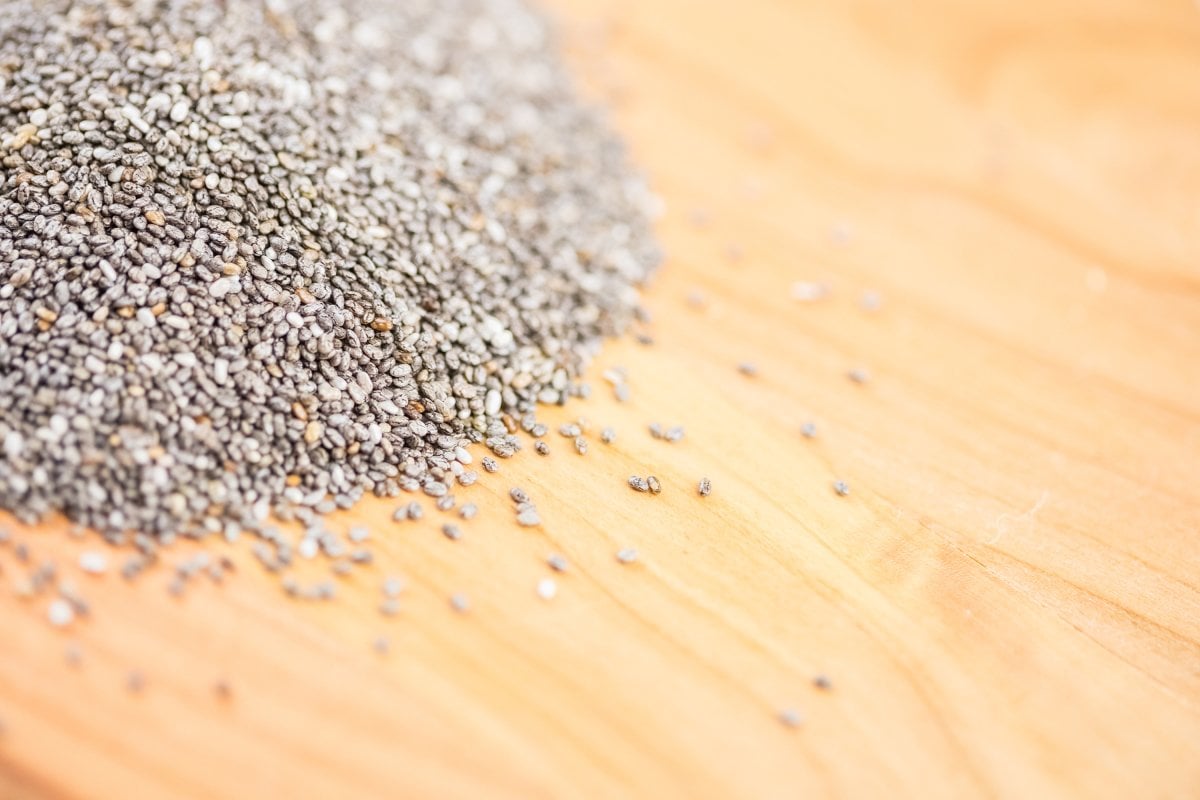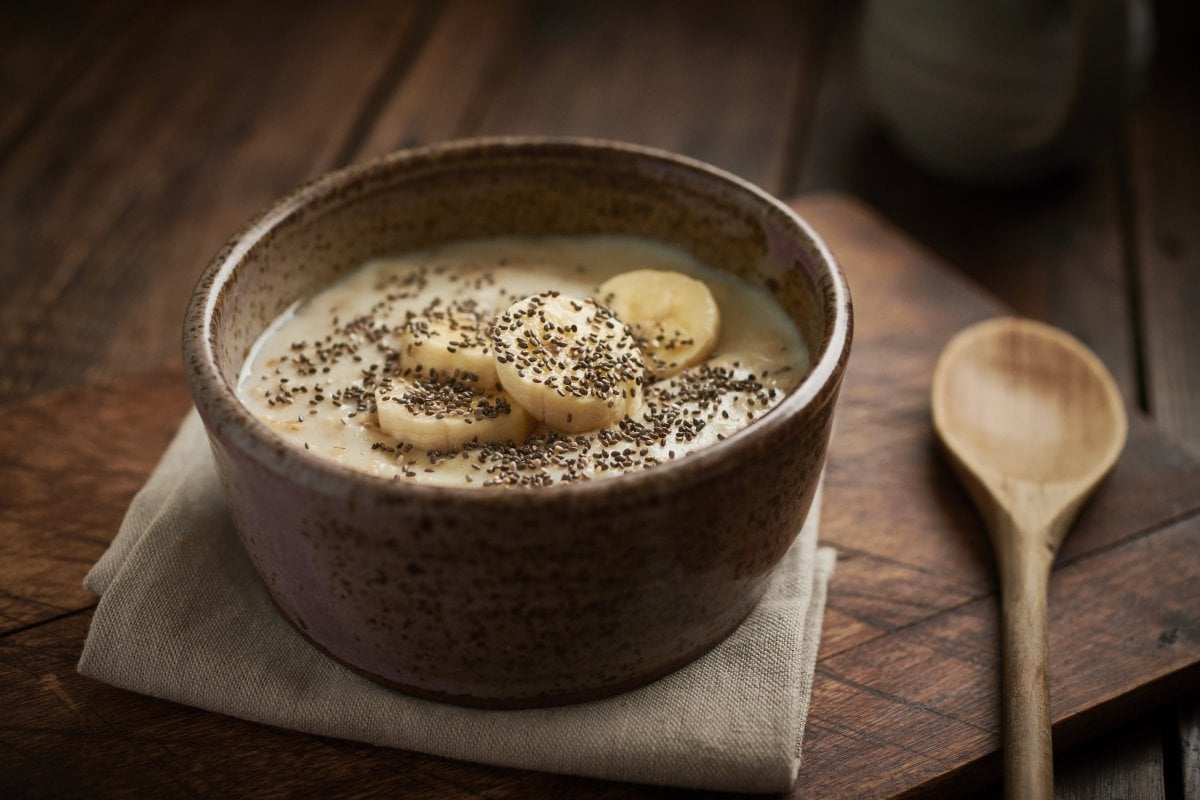If your mind immediately goes to “Ch-ch-ch-chia!” when you think of chia seeds, you’re not alone (and I realize I’m dating myself by saying that). Chia Pets, which came into popularity in the 1980s, were the first way that many in my generation were introduced to these seeds.
Today, of course, chia seeds come to us in a very different form. In recent years, they’ve become a popular health food with a number of health benefits.
What Are Chia Seeds?
Chia seeds are tiny, round seeds of the Salvia hispanica plant. They’re typically black or white, with no significant nutritional differences between the two colors. If you see brown seeds, they are not fully mature.
This plant, related to mint, is native to the deserts of Mexico and Guatemala. Today, chia seeds are grown in various parts of the United States, as well as Argentina, Australia, Peru, and Bolivia, with around 80% of the world’s supply coming from South America. However, the U.S. is the largest chia seed consumer, importing around 15,000 tons annually.
Even though chia seeds are still fairly new to the mainstream health community, native people have used them for thousands of years. In fact, they’ve been used for medicinal, religious, and culinary purposes throughout history.
Chia seeds have traditionally been ground into flour, pressed for oil, and mixed into drinks. The ancient Aztecs saw them as sacred and used them in sacrificial ceremonies. The traditional Mayans believed chia seeds had supernatural powers, and they were used to provide travelers with energy for long journeys.
Today, members of the Mexican Tarahumara tribe — known for being long distance runners — drink a mixture of chia seeds, lemon, and water called “Iskiate.” They believe chia seeds provide them with the strength to run hundreds of miles. (Their whole foods, plant-powered diet probably doesn’t hurt, either.)
Chia Seed Nutrition
The word “chia” is derived from the Aztec word “Chian,” which means oily. While you can press chia seeds for oil, “oily” isn’t what comes to mind when I think about eating them, although admittedly I’m not Aztec.
The main fats in chia seeds are mostly omega-3s — especially alpha-linolenic acid (ALA), which accounts for three-quarters of the total — and some omega-6s. ALA is an important omega-3 fat and a precursor for your body to make DHA and EPA, two other very important omega-3 fats.
As small as they are, chia seeds pack a lot of nutrition. In every 1 tablespoon of seeds, you’ll find 2.1 grams of ALA, 4 grams of fiber and 2 grams of protein. They’re also a rich source of vitamins and minerals, especially calcium, phosphorus, and zinc.
You can eat them raw, or mix them into baked goods, puddings, or other dishes, where they add a mild, crunchy, nutty flavor.
Today, you can buy chia seeds at a wide range of both mainstream and health food grocery stores. You can find them dried and in the bulk foods section.
9 Health Benefits of Chia Seeds

1) They support your digestive health.
Chia seeds are an excellent source of fiber, especially insoluble fiber, which is an important nutrient for your digestive system. Insoluble fiber acts like a broom for your digestive tract, cleaning it out and keeping it healthy.
Eating enough fiber can reduce your risk for many digestive diseases, such as colorectal cancer.
The fiber from chia seeds also serves as a needed nutrient for the beneficial bacteria in your microbiome, which in turn reduces inflammation throughout your body.
The recommended minimum amount of daily fiber intake is 25 grams for women and 38 grams for men, and only a small percentage of people actually meet that daily minimum. But adding a couple of tablespoons of chia seeds to your routine will get you well on your way to meeting and — with the help of some fruits and vegetables — even surpassing that daily minimum.
2) They’re good for your brain.
A 2018 study published in the Global Journal of Health Science divided German college students into two groups: a control group and a group that consumed 5 grams of chia seeds daily for 21 days. Researchers found that those who ate chia seeds performed significantly better on an academic test than the control group.
Coincidence? A total of 34,600 college students participated in this study, so probably not. My bet would be on the omega-3 boost their brains got. Why? Omega-3 fats, like the ALA in chia seeds, are essential for brain function and improved cognition.
3) They help keep your bones strong.
Chia seeds are a good source of many minerals, including calcium, phosphorus, and magnesium, that are needed for bone strength. The dairy industry likes to portray milk products as necessary for strong bones. But plant-sourced calcium has been proven to be effective in increasing bone density.
And animal studies have shown that rats fed a diet made up of 10% chia seeds over 13 months had significantly higher bone density than rats on a low calorie diet sans chia seeds.
4) They can reduce inflammation.
The ALA in chia seeds has an anti-inflammatory effect. Chronic inflammation can promote various diseases in the body, such as autoimmune diseases, infectious diseases, heart disease, type 2 diabetes, and certain cancers. Research has shown ALA to be particularly effective in reducing inflammation among people with metabolic syndrome (high blood pressure, high cholesterol, high blood sugar, excess abdominal fat) and related diseases.
5) They keep your blood sugar stable.
The high fiber content in chia seeds helps to keep your blood sugar stable. Fiber slows digestion, preventing blood sugar from spiking after a meal. Fiber also promotes satiety, or the feeling of fullness after a meal. This has been demonstrated specifically with the addition of chia seeds to people’s diet.
6) They’re good for your heart.
The ALA in chia seeds can also protect your heart. A 2012 meta-analysis looked at 27 studies, which included over 250,000 participants, to see if there was a relationship between ALA intake and heart disease risk. Researchers found that people who consumed a high amount of ALA experienced up to a 10% lower risk of heart disease.
Another study of 3,638 people found that those who consumed around 18 grams of ALA per day had a 39% lower risk of heart disease than those who consumed less ALA. Chia seeds can also benefit your heart by helping to lower your blood pressure.
7) They may help lower your risk for certain cancers.
The ALA in chia seeds may also have cancer-preventing properties. A 2013 in vitro study published in the Journal of Molecular Biology demonstrated the ability of ALA to slow the growth of breast and cervical cancer cells. It also promoted cell death of cancer cells while not affecting the healthy cells. While more research is needed to apply this to humans, other studies have shown a similar effect of ALA on liver cancer cells.
8) They can help keep your skin healthy.
Chia seeds are full of antioxidants that are known to be protective against the skin damage caused by free radicals. A 2014 study published in the Journal of Chromatography A found that chia seeds had much higher antioxidant capacity than previously thought. In the study, chia seeds inhibited up to 70% of free radical activity.
9) They can fuel your endurance.
Remember the Mexican Tarahumara tribe runners I mentioned earlier? They appear to be onto something with their use of chia seeds to fuel their runs. A 2011 study published in the Journal of Strength and Conditioning Research found that chia seeds are an effective option for fueling endurance exercise, while avoiding the sugar that’s found in Gatorade and other traditional sports drinks.
Potential Downsides to Chia Seeds
Chia seeds are a highly nutritious food, but there are some things to keep in mind if you choose to eat them.
- They might cause an upset stomach. Too much fiber can cause bloating, gas, and abdominal pain, especially if you aren’t used to eating much of it. If this happens to you, the best answer may be to work your way up slowly.
- They may interact with certain medications. Chia seeds can significantly reduce blood sugar, a generally healthful outcome that nonetheless could be dangerous for those taking medications designed to do the same thing. Chia seeds can also lower blood pressure, so if you’re taking blood pressure medication, it may be wise to monitor your blood pressure while adding chia to your diet.
- While not common, there are a few people who have a chia seed allergy. Some people have experienced anaphylaxis and dermatitis after eating chia seeds. People who have any sensitivity to thyme, mustard, oregano, or sesame seeds may want to be cautious with chia seeds.
Chia Seeds: Whole or Ground?

You may be aware that in order to increase absorption and get the most nutritional value from flaxseeds, they should be ground before you eat them. Is this also true for chia seeds? A 2012 study published in the Journal of Alternative and Complementary Medicine helps answer that question.
The study involved 62 overweight women, with no known diseases, between the ages of 49-75 years. They ate two tablespoons of whole chia seeds per day for ten weeks, at which point they saw no change in their blood omega-3 levels. However, when they ate the same amount of chia seeds — but in ground form — their blood omega-3 levels increased significantly after another ten weeks. Levels of alpha-linolenic acid (ALA) increased by 58% and levels of eicosapentaenoic acid (EPA) increased by 39%.
It turns out that many people don’t chew whole chia seeds enough to break them down fully. As a result, they can go “in one end, and out the other.” Grinding them is a good way to ensure that you’re getting their full nutritional value.
My dad likes to use a coffee grinder to do this.
How To Enjoy Chia Seeds

Chia seeds, whether ground or not, are a versatile food to have on hand. You can add them to salads, to hot oatmeal, and to many other dishes. If you’re making pancakes or muffin, you can mix them into the batter. You can also add ground chia seeds to smoothies and other blended foods. Or you can sprinkle ground chia seeds on just about any savory dish (and some sweet ones, too!).
Did you know you can also use chia seeds to replace eggs in baking? The basic recipe is 1 tablespoon of chia seeds to 2 ½ tablespoons of water. Gently stir together the seeds with the water, and let the mixture sit for about five minutes. Just as you would use eggs as a binding agent in baking, chia seeds will form a gel that keeps your recipe together. (The gel will last in your fridge for about two weeks.)
Here are some great ways to use chia seeds.
Overnight Chocolate Chia Seed Pudding by Minimalist Baker – This is a creamy, chocolatey pudding that can be enjoyed any time of day. You can choose to omit the maple syrup for a low-sugar version.
Raspberry Chia Seed Jam by Gimme Some Oven – This is an incredibly easy homemade jam that requires only a few ingredients. With the sweetness of the berries, you don’t need to add additional sugar.
Strawberry Banana Chia Seed Smoothie by Jar of Lemons – Four ingredients and loads of nutrition in this one! You could easily swap out other fruits of choice with this recipe.
Chias to Your Health
Chia seeds may be tiny, but it’s clear that they’re nutritional powerhouses with a lot to offer. Packed with fiber, protein, healthy fats, vitamins, and minerals, chia seeds are a convenient way to add a lot of benefits to your diet.
And in case you were wondering, Chia Pets do still exist. (People would buy terracotta figurines to sprout chia seeds. The chia sprouts grow within a couple of weeks to resemble an animal’s fur or hair.) Some people may enjoy Chia Pets, but I think chia seeds are far more useful when you eat them as the highly nutritious food that they are…
Tell us in the Comments:
- Do you eat chia seeds? Why or why not?
- What is your favorite way to use them?
Featured Image: iStock.com/YelenaYemchuk




